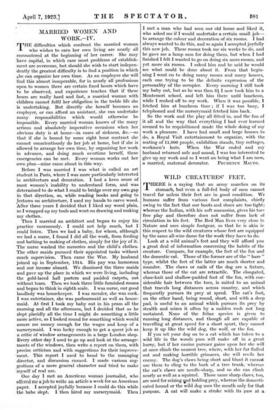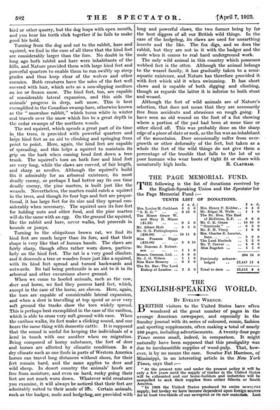WILD CREATURES' FEET.
THERE is a saying that an army marches on its stomach, but even a full-fed body of men cannot travel fax unless their feet are in good condition. We humans suffer from various foot complaints, chiefly owing to the fact that our boots and shoes are too tight; whereas the Indian, with his soft mocassins, gives his toes free play and therefore does not suffer from lack of circulation in his feet. The Red Man lives very close to Nature and uses simple footgear, so that he is akin iu this respect to the wild creatures whose feet are equipped by the same all-wise dame for the work they have to do.
Look at a wild animal's feet and they will afford you a great deal of information concerning the habits of the creature. Compare, for example, the feet of the fox and the domestic cat. Those of the former are of the " hare" type, whilst the feet of the latter are much shorter and rounder. The claws or nails of the dog are a fixture, whereas those of the cat are retractile. The elongated, close-knit and shallow-padded foot of the fox, with con- siderable hair between the toes, is suited to an animal that travels long distances across country, and which frequently pursues its prey at speed. The cat's foot, on the other hand, being round, short, and with a deep pad, is useful to an animal which pursues its prey by stealth and seizes it often by a sudden rush not long sustained. None of the feline species is given to running long distances, and though all are capable of travelling at great speed for a short spurt, they cannot keep it up like the wild dog, the wolf, or the fox.
If you set your dog on to a cat which has taken to a wild life in the woods puss will make off in a great hurry, but if her canine pursuer gains upon her she will at once climb the nearest tree, where, with her fur fluffed out and making horrible grimaces, she will revile her enemy. The dog's claws being short and blunt it cannot use them to cling to the bark of a tree trunk, whereas the cat's claws are needle-sharp, and so she can climb nearly as well as a squirrel. Those same sharp claws, too, are used for seizing %nd holding prey, whereas the domesti- cated hound or the wild dog uses the mouth only for that purpose. A cat will make a stroke with its paw at a bird or other quarry, but the dog leaps with open mouth, and you hear his teeth click together if he fails to make good his hold. Turning from the dog and cat to the rabbit, hare and squirrel, we find in the case of all three that the hind feet are considerably larger than the fore. No doubt in the long ago both rabbit and hare were inhabitants of the hills, and Nature provided them with large hind feet and powerful quarters to enable them to run swiftly up steep grades and thus keep clear of the wolves and other enemies. Both creatures have the soles of the feet well covered with hair, which acts as a non-slipping medium on ice or frozen snow. The hind feet, too, are capable of considerable lateral expansion, and this aids the animals' progress in deep, soft snow. This is best exemplified in the Canadian swamp hare, otherwise known as the "snowshoe rabbit," which turns white in winter and travels over the snow which lies to a great depth in the cedar swamps of the northern woods.
The red squirrel, which spends a great part of its time in. the trees, is provided with powerful quarters and large hind feet as an aid to climbing and springing from point to point. Here, again, the hind feet are capable of spreading, and this helps a squirrel to maintain its grip on the bark when coming head first down a tree trunk. The squirrel's toes on both fore and hind feet are very long, while the claws are curved, of fair length, and sharp as needles. Although the squirrel's build fits it admirably for an arboreal existence, its most deadly enemy, or perhaps I had better say its one time deadly enemy, the pine marten, is built just like the weasels. Nevertheless, the marten could catch a squirrel in the trees, and though its four legs and feet are propor- tional, it has large feet for its size and they spread con- siderably when necessary. The squirrel uses its fore feet for holding nuts and other food, and the pine marten will do the same with an egg. On the ground the squirrel, like the rabbit and hare, never walks, but proceeds in bounds or jumps.
Turning to the ubiquitous brown rat, we find its hind feet are much larger than its fore, and that their shape is very like that of human hands. The claws are fairly sharp, though often rather worn down, particu- larly on the hind feet. The rat is a very good climber, and it descends a tree or wooden fence just like a squirrel, with its hind feet spread and turned backwards and outwards. Its tail being prehensile is an aid to it in its arboreal and other excursions above ground.
When we come to hoofed animals, such as the cow, • deer and horse, we find they possess hard feet, which, except in the case of the horse, are cloven. Here, again, the toes are capable of considerable lateral expansion, and when a deer is travelling at top speed or over very soft ground the tracks show the toes widely spread. This is perhaps best exemplified in the case of the caribou, which is able to cross very soft ground with ease. When the caribou walks, its feet make a clicking sound, and one hears the same thing with domestic cattle. It is supposed that the sound is useful for keeping the individuals of a herd in touch with one another when on migration. Being composed of horny substance, the feet of deer and horses are affected by climatic conditions. In a dry climate such as one finds in parts of Western America horses can travel long distances without shoes, for their feet remain hard, and the same applies to deer and wild sheep. In desert country the animals' hoofs are free from moisture, and even on hard, rocky going their feet are not much worn down. Whatever wild creatures you examine, it will always be noticed that their feet are Admirably suited to their mode of lire. Certain Finirnal; such as the badger, mole and hedgehog, are provided with long and powerful claws, the two former being by far the best diggers of all our British wild things. In the case of the hedgehog, its Claws are used for unearthing insects and the like. The fox digs, and so does the rabbit, but they are not in it with the badger and the mole when it comes to real hard underground work.
The only wild animal in this country which possesses webbed feet is the otter. Although the animal belongs to the weasel family; it has gradually taken to a semi- aquatic existence, and Nature has therefore provided it with feet which aid it when swimming. It has short claws and is capable of both digging and climbing, though as regards the latter it is inferior to both stoat and weasel.
Although the feet of wild animals are of Nature's selection, that does not mean that they are necessarily free from accidents and abrasions on rough going. I have seen an old wound on the foot of a fox showing where a portion of the pad had been at some time or other sliced off. This was probably done on the sharp edge of a piece of slate or rock, as the fox was an inhabitant of the mountains. Deer occasionally suffer from over- growth or other deformity of the feet, but taken as a whole the feet of the wild things do not give them a percentage of the trouble that falls to the lot of us poor humans who wear boots of tight fit or shoes with











































 Previous page
Previous page